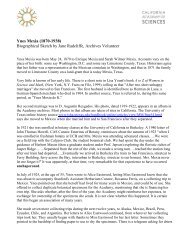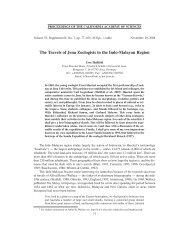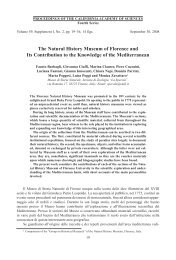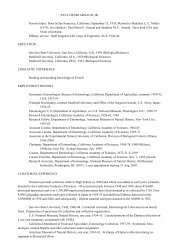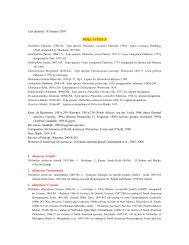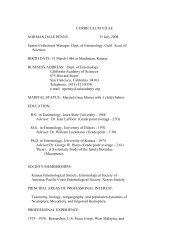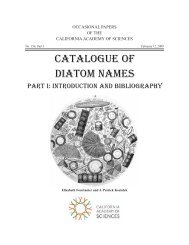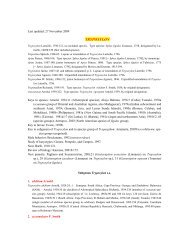Cimino&Ghiselin-tmpZXYZ:Template Proceedings_1.qxd.qxd
Cimino&Ghiselin-tmpZXYZ:Template Proceedings_1.qxd.qxd
Cimino&Ghiselin-tmpZXYZ:Template Proceedings_1.qxd.qxd
Create successful ePaper yourself
Turn your PDF publications into a flip-book with our unique Google optimized e-Paper software.
210 PROCEEDINGS OF THE CALIFORNIA ACADEMY OF SCIENCES<br />
Series 4, Volume 60, No. 10<br />
Part 2. Prokaryotes<br />
Prokaryotes are distinguished from eukaryotes on the basis of the structure of the cell. The<br />
prokaryote cell is simpler than the eukaryote cell and lacks such features as a nucleus and the membrane<br />
that surrounds it. The prokaryotes consist of two major groups of bacteria, Archaebacteria<br />
and Eubacteria. The Eukaryotes are more closely related to the Archaebacteria than to Eubacteria:<br />
in other words the bacteria are a paraphyletic group. The Eubacteria include all of the bacteria that<br />
are of interest in this discussion, and these belong to two closely-related lineages, the<br />
Actinobacteria and Cyanobacteria. The Cyanobacteria were formerly considered plants and were<br />
called blue-green algae, or Cyanophyta. They form small filaments that are readily visible to the<br />
naked eye, and superficially resemble some true algae. A case of poisoning that occurred when people<br />
in Hawaii ate the red alga Gracillaria coronopifolia was later attributed to the cyanobacteria<br />
growing epiphytically on it (Nagai, Yasumoto & Hokama, 1997).<br />
Animals that feed on prokaryotic or eukaryotic “algae” sometimes have switched from one to<br />
the other during the course of evolution. This is but one example of how the texture and metabolite<br />
content of the food are often more important than its taxonomy. Bacteria are noteworthy for<br />
their chemical versatility. Many of them synthesize metabolites that eukaryotes do not. They are<br />
particularly important as symbionts that synthesize alkaloids, macrolides, and polyketides. Bacteria<br />
that live as symbionts within the bodies of marine animals such as sponges and sea-squirts are the<br />
source of alkaloids and some other secondary metabolites. (For review of marine microorganisms<br />
and fungi with secondary metabolites, see Pietra, 1997; Bernan, 2001; Engel, Jensen & Fenical,<br />
2002).<br />
Some unfortunate claims have occasionally made, even in print, about the putative role of<br />
symbionts in producing secondary metabolites. A particularly glaring example is to be found in a<br />
recent publication by Castoe, Stephens, Noonan and Calestani (2006:“2”): “Polyketide compounds,<br />
used as defensive mechanisms to deter predation, have been isolated from some marine<br />
invertebrates (e.g., sponges and mollusks; Garson, 1989), although these polyketides were subsequently<br />
found to be produced by bacterial symbionts (and not encoded in the animal genomes).”<br />
What the authors allege simply is not true. They do not cite a single publication in favor of their<br />
claim, and had anything of the sort been published it would surely have been brought to our attention.<br />
One way or another, what perhaps began as a mere speculation thrown out in casual conversation<br />
has become a rumor, or even what is sometimes called an “urban myth.” Now, given the fact<br />
that some, indeed many, animals make use of metabolites that are produced by their symbionts, it<br />
is perfectly reasonable to ask, in any given case, whether it is the host or some guest that synthesizes<br />
it. There are two possibilities and we need to apply the proper canons of evidence to decide<br />
between them, just as we do when deciding whether metabolites are produced endogenously or are<br />
derived from food. Many opisthobranchs obtain metabolites by eating other organisms that in turn<br />
get them from symbionts. It has not been difficult to recognize those symbionts, which exist in substantial<br />
numbers and are located in particular tissues and specialized organs within the body of the<br />
host. In opisthobranchs there are no tissues or organs that are reasonable candidates for harboring<br />
such a population of symbionts, and no such populations have been identified. In those cases where<br />
biosynthesis has been studied experimentally, and in which the biology of the animals is well<br />
understood, the production of metabolites by symbionts, although perhaps not as rigorously<br />
excluded as a hostile critic might demand, is highly implausible. In the cephalaspidean Haminoea,<br />
for example, the animal biosynthesizes defensive metabolites called fusipyrones. But the animals<br />
also biosynthesize a series of metabolites called haminols, which are not defensive. Rather they<br />
function as alarm pheromones, which alert conspecifics to attack by predators, and probably also




